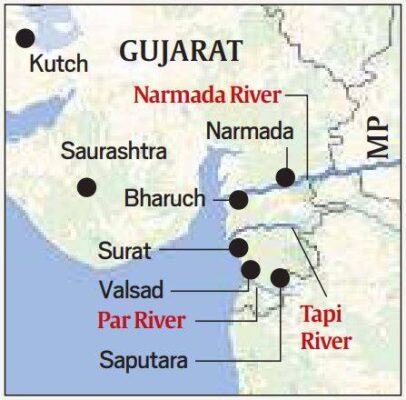- Home
- Prelims
- Mains
- Current Affairs
- Study Materials
- Test Series
Par-Tapi-Narmada
 The tribals in Gujarat held a public meeting in Kaprada in Valsad district to protest against the Centre’s Par Tapi Narmada (PTN) river-linking project.
The tribals in Gujarat held a public meeting in Kaprada in Valsad district to protest against the Centre’s Par Tapi Narmada (PTN) river-linking project.
- These projects had been sanctioned in 2010, when a tripartite agreement was signed between the Union government, Gujarat and Maharashtra.
- The Finance Minister in her Budget Speech said that five river linking projects will be taken up after consensus among states.
- The projects are Damanganga-Pinjal, Par-Tapi-Narmada, Godavari-Krishna, Krishna-Pennar and Pennar-Cauveri.
- The Ken-Betwa is the first project under the government's National Perspective Plan for river inter-linking.
- The National River Linking Project (NRLP) formally known as the National Perspective Plan, envisages the transfer of water from water 'surplus' basins where there is flooding, to water 'deficit' basins where there is drought/scarcity, through inter-basin water transfer projects.
- Par Tapi Narmada Link proposes to transfer water from the water surplus regions of Western Ghats to the water deficit regions of Saurashtra and Kutch (Gujarat).
- The link project includes seven reservoirs proposed in north Maharashtra and south Gujarat.
- The water from the seven proposed reservoirs would be taken through a 395 km long canal to take over a part of the command of the on-going SardarSarovar Project (on Narmada), while irrigating small enroute areas.
- The seven dams proposed in the scheme are Jheri, Mohankavchali, Paikhed, Chasmandva, Chikkar, Dabdar and Kelwan.
- This would save SardarSarovar water which will be used to extend irrigation in Saurashtra and Kutch region.
- The link mainly envisages construction of seven dams, three diversion weirs, two tunnels, 395 km long canal, 6 power houses and a number of cross-drainage works.
Narmada River
|
- Irrigation benefits:
- Containing flood-like situations: The project aims to make use of the excess water that flows into the sea by interlinking the rivers. This will help in containing regular flood-like situations in the rivers in Valsad, Surat, Navsari and Bharuch.
- Submergence of Land: As per a report by the National Water Development Agency (NWDA), about, 6065 ha of the land area will be submerged due to the proposed reservoirs. Out of 61 villages, 60 will be partially submerged and one will be fully submerged.
- Displacement of People: According to a report by the National Water Development Agency (NWDA):
- The total number of affected families would be 2,509 of which 98 families would be affected due to the creation of the Jheri reservoir (the only one in Maharashtra) spread over six villages.
- In Gujarat, 793 families from various villages will be affected by the Kelwan reservoir, 563 families by the Dabdar reservoir, 379 families by Chasmandva reservoir spread over 7 villages, 345 families would be affected by Chikkar reservoir and 331 families would be affected due to Paikhed reservoir. People may lose their houses or lands or both due to the construction of dams.
- Environmental Impact: The Par Tapi Narmada river-linking project will affect the ecosystem in and around the river systems as well as the marine ecosystem, to which these rivers carry freshwater.









 Latest News
Latest News
 General Studies
General Studies